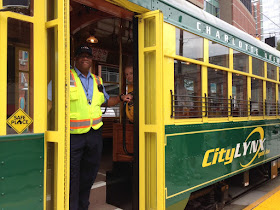 In the category of "Found while looking up other stuff" I came across this amazing map of 1945 Charlotte, and all the passenger and freight rail lines that fed uptown. It's from a 1945 Chamber of Commerce brochure, and you can find it, too, on the website of the Charlotte-Mecklenburg Historic Landmarks Commission.
In the category of "Found while looking up other stuff" I came across this amazing map of 1945 Charlotte, and all the passenger and freight rail lines that fed uptown. It's from a 1945 Chamber of Commerce brochure, and you can find it, too, on the website of the Charlotte-Mecklenburg Historic Landmarks Commission.It's a little difficult to tell from the cute drawing how many of those rail lines carried passengers as well as freight, but the Piedmont and Northern to Gastonia was an electrified passenger rail - today we'd call it commuter rail.
The line is still used. It runs west and northwest from uptown Charlotte near the NFL stadium, through the Wesley Heights neighborhood, then crosses the Catawba River and goes through Mount Holly, Belmont and into Gastonia. The N.C. Department of Transportation owns much of the right-of-way, except for an important segment beyond Wesley Heights and the river, which is owned by CSX. (See final paragraph of this report.)
The old Southern Railway passenger terminal was on West Trade near what's now the Greyhound Bus station, but it was demolished years ago. The 1895 Seaboard Air Line depot, between North Tryon and North College streets - depicted on the 1945 map as S.A.L. RR now the Urban Ministry Center.
Rail junkies may enjoy this 2008 map of the N.C. rail lines, which lists ownership of the segments.



